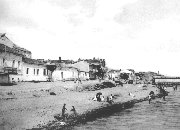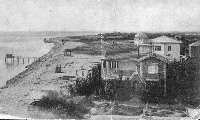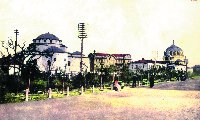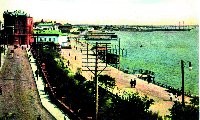 |
| Evpatoria: District Capitol |
|---|
| For Evpatoria’s development and economic activity, empress Catherine II, presented the town with significant privileges. The town’s inhabitants and even foreigners could ‘without payment’ erect buildings, mills and factories, shops and other enterprises. The land under the buildings was given free to whoever wanted it. Stone from destroyed defensive buildings was allowed to be used for free for construction. The ruins of the fortress walls and towers basically disappeared during these years. At the end of the eighteenth century, more than 4,000 people lived in the town, basically the petty bourgeois and merchants. | |
|
In 1798, Emperor Paul I signed a manifesto "for encouraging trade and assisting the population and for the further establishment of the city and its lands," and the Crimean peninsula was declared for 30 years a ‘port-franc’, i.e. with the right of duty-free import and export. Those resettling to the town were given places to build up for free and without concern for rank or class, were allowed to open up city trade and to build factories and mills. In 1825, Anatolian Greeks were permitted duty-free retail businesses and were allowed to keep coffeehouse and bath houses without registration in the merchant’s guild. The town’s population at this time exceeded 11,000.
 Evpatoria was very popular not just in Crimea, but also Russia, Turkey, Greece and Italy also took part in Evpatoria’s fairs conducted twice a year (May 1 and September 1). Silk, wool, cotton fabric, grain, spice, leather and salt were all traded at this fair.
Evpatoria was very popular not just in Crimea, but also Russia, Turkey, Greece and Italy also took part in Evpatoria’s fairs conducted twice a year (May 1 and September 1). Silk, wool, cotton fabric, grain, spice, leather and salt were all traded at this fair.
At the beginning of the nineteenth century, Evpatoria had the largest number of trade institutions in Crimea: more than 1,000 shops and 20 courtyards for merchants to reside in and keep their goods. In the middle of the nineteenth century, candle, leather, felt and soap enterprises operated in the town. Jewelry, shoemakers, blacksmiths and cooper enterprises developed in the town. The products of Evpatorian craftsmen (particularly jewelry) were marketed not just in Crimea, but also went out for export.
In the middle of the nineteenth century, the town’s population was about 13,400: third in size in Crimea after Sevastopol and Simferopol. In Evpatoria there were thirty workshops and factories: nine felt makers, ten leather operations and eleven candle and soap enterprises. By this time, the town’s territory had increased and new streets and lanes appeared with houses numbering around 2,000. The town began to improve and equip itself: the first artesian well was set in 1834 and construction of the embankment began in 1840. In these years, Evpatoria was surrounded on all sides by endless rows of wind mills. "Just like fairy-tale regiments of giants, they surrounded the city and waved their gigantic hands at it," noted a publication of that time.
However the Crimean war of 1854 to 1856 led to interruptions in Evpatoria’s development...
In 1867, a general plan to regulate construction development was ratified for the first time. From the end of the nineteenth century, a new era in the city’s development began. Evpatoria began to develop as a city-resort. Already in 1875, V. Kondaraki noted in his travels about Evpatoria’s resort direction: "The city in the summer time presents an active appearance as it is flooded with crowds of visitors, refreshing their nerves with sea bathings".
 Intensive construction of dachas in the town began in 1893. At that time the territory of a state lake was redeemed, drained and united with land, stretching up to the neck of Lake Moynaki. All of this territory gained by the town was divided into equal areas for sale for the building of dachas and development of orchards.
Intensive construction of dachas in the town began in 1893. At that time the territory of a state lake was redeemed, drained and united with land, stretching up to the neck of Lake Moynaki. All of this territory gained by the town was divided into equal areas for sale for the building of dachas and development of orchards.
The development of the resort promoted the growth of the city as a whole. The city’s industry began to develop as well. The need for the building materials in this quickly growing city was satisfied by quarries, where in the mid 1870s industrial mining of sand/shell stone began. The abundance of salt lakes around Evpatoria promoted the development of a salt mining industry and at the beginning of the twentieth century rapid development of flour-milling productions began. In 1903, the cast-iron foundry plant Katzen and Vilensky (now a mechanical plant) went into production as well as a brick/tile plant, the mechanical plant Phitzye and Chalago, a printing house and a number of small, handicraft workshops. Nevertheless, there is still a great deal to remind one of the old medieval city. In one of the oldest guidebooks, Evpatoria’s centuries of antiquity were described:
"Evpatoria’s best buildings are located along the seashore where the boulevard is. This part of the city has a more or less improved appearance: streets are paved with sidewalks and are illuminated at night, the buildings are of European architecture and there are decent shops. On the other hand, the remaining portion of Evpatoria preserves the character of a Tatar city with narrow, crooked dirt roads: buildings with windows looking into courtyards and mosques with pointed minarets. From the old Tatar city of Gozlov, as Evpatoria was previously called, the wall ruins, market gates and the large Juma-Jami mosque built in 1552 by khan Devlet-Hirem all survive.
 For taking walks, there is small seaside boulevard with vegetation and a military orchestra plays here daily during the season. It is impossible to walk on the street because it is very dusty, and quarters far from the Black Sea are generally untidy. The public park around the old artesian well is open to the public but is still very new.
For taking walks, there is small seaside boulevard with vegetation and a military orchestra plays here daily during the season. It is impossible to walk on the street because it is very dusty, and quarters far from the Black Sea are generally untidy. The public park around the old artesian well is open to the public but is still very new.
At this time, the town’s managers had attention only for the importance of Evpatoria for trade and obviously took little care of her as a Crimean resort, but in the meantime, each year more and more people come here to use the sea and to bathe in the mud estuaries".
Charitable help for the poor and elderly was generously supplied. Evpatoria at the end of the nineteenth century had a shelter for the elderly, a town poorhouse and six guardianships for the poor. In 1892, with a poor harvest, well-to-do people felt a duty to help the poor. The district guardianships immediately opened four free cafeterias.
 The appearance of cars was a sign of the civilized development of the town. For the safety of its citizens, in 1908 the Evpatoria Duma passed a resolution managing car travel in Evpatoria. According to this, travel by car was allowed on roads in the central and dacha areas at speeds of up to twelve Verst (just over a kilometer) but only up to six Verst an hour, on streets less than eight Arshine (2 feet, 4 inches) wide. On narrower streets driving was generally not allowed. For traveling in places with crowds of people or supplies, the car’s speed must be reduced to the pace of a horse. But if horses show nervousness, the motorist must turn off the motor. With these speeds, travel from Evpatoria to Simferopol and back took four to five hours. The cost of tickets for riding a car was five to six rubles.
1908 was the year Evpatoria got electricity. The ‘Evpatorian Pamphlet’ stated: “On February 10 of this year, inhabitants of Evpatoria were surprised by an extraordinary light, looking like the moon, coming from great white torches. People rushed under them, children spun with joy, animals became frightened and dashed away from the torches. Thus Evpatoria was one of the fourth group of ten Russian cities in which electric street lights appeared.” Engineer D. Cherkes and architect P. Seferov built on the Black Sea shore, near to the Seaside Sanatorium, a central electric station, in which was installed a gas-plant of sixty power, dynamo-machine of 138 amperes and a storage battery of 108 amperes at 220 volts. The machines were put into motion by gas from anthracite. On June 10, a telephone line from Evpatoria to Simferopol was put up. A three-minute talk between Evpatoria and Saki cost subscribers thirty kopecks while one from Evpatoria to Simferopol was fifty kopecks.
In connection with its development as a resort, Evpatoria was enlarged and improved. A modern Theater Square was designed and built. Evpatoria’s population in 1912 was around 30,000 people. The reference book ‘Evpatoria Resort in Crimea’ released in the summer of 1914 describes Evpatoria:
The appearance of cars was a sign of the civilized development of the town. For the safety of its citizens, in 1908 the Evpatoria Duma passed a resolution managing car travel in Evpatoria. According to this, travel by car was allowed on roads in the central and dacha areas at speeds of up to twelve Verst (just over a kilometer) but only up to six Verst an hour, on streets less than eight Arshine (2 feet, 4 inches) wide. On narrower streets driving was generally not allowed. For traveling in places with crowds of people or supplies, the car’s speed must be reduced to the pace of a horse. But if horses show nervousness, the motorist must turn off the motor. With these speeds, travel from Evpatoria to Simferopol and back took four to five hours. The cost of tickets for riding a car was five to six rubles.
1908 was the year Evpatoria got electricity. The ‘Evpatorian Pamphlet’ stated: “On February 10 of this year, inhabitants of Evpatoria were surprised by an extraordinary light, looking like the moon, coming from great white torches. People rushed under them, children spun with joy, animals became frightened and dashed away from the torches. Thus Evpatoria was one of the fourth group of ten Russian cities in which electric street lights appeared.” Engineer D. Cherkes and architect P. Seferov built on the Black Sea shore, near to the Seaside Sanatorium, a central electric station, in which was installed a gas-plant of sixty power, dynamo-machine of 138 amperes and a storage battery of 108 amperes at 220 volts. The machines were put into motion by gas from anthracite. On June 10, a telephone line from Evpatoria to Simferopol was put up. A three-minute talk between Evpatoria and Saki cost subscribers thirty kopecks while one from Evpatoria to Simferopol was fifty kopecks.
In connection with its development as a resort, Evpatoria was enlarged and improved. A modern Theater Square was designed and built. Evpatoria’s population in 1912 was around 30,000 people. The reference book ‘Evpatoria Resort in Crimea’ released in the summer of 1914 describes Evpatoria:
 "Evpatoria is the closest port from Odessa on the Crimea-Caucuses lines and is of great importance as a point of export. Evpatoria is primarily known for its image as a resort in the Russia sea, with estuaries for bathings and curative muds.
"Evpatoria is the closest port from Odessa on the Crimea-Caucuses lines and is of great importance as a point of export. Evpatoria is primarily known for its image as a resort in the Russia sea, with estuaries for bathings and curative muds.
The town’s total area spreads out over 5.8 square Verst. The town’s buildings are all stone... City trade enterprise number up to 500 with annual transactions of more than ten million rubles. Particularly typical of Evpatoria is the vacation trade of rural products (bread, wool, honey and sheepskins), as well as lake salt. The city divides into three areas differing from each other: the old city, the new city and the dacha region...".
At the beginning of the first world war, three sanatoriums worked in Evpatoria for adults and five for children. But treatment there was only available for well-to-do people. So there was a large increase in the number of rooming houses and hotels for people of varying means. For example, in the comfortable hotel ‘Russia’ located right on the sea shore with warm sea baths and swimming, a room cost from one to five rubles a day, but in the second tier ‘European’ it was from fifty kopecks to three rubles a day. Renting an apartment with furniture and meals was available for 25 to 30 rubles which, at that time, was considered quite reasonable...
The year 1917 drastically changed life not just for our city, but also for the whole country... | |

